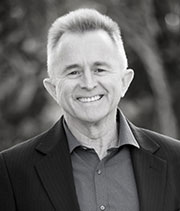Using a face-reading technique called Rapid Trait Profiling combined with analysis of facial expressions and micro-facial expressions, as well as NLP techniques, Alan is very quickly able to determine someone’s personality and emotions – even if that is something they are trying to conceal.
“I clear rooms,” said Alan on the topic of what ‘exactly’ he does. “Often people are afraid that I will see the worst in them, but what I do isn’t about character; it’s about personality and communication styles.
“You can have two people with the same traits – one good and one bad. It’s about creating enhanced relationships and understanding the people around you.”
In a business where first impressions count and the X-factor of ‘rapport’ will win and lose deals, being better placed to read and understand what people want is the ultimate competitive advantage.
According to Alan, face-reading can be done by “looking at the ridges and crevices that form through repeated muscle action”. A person’s face then tells a story of how they like to take in information and how they prefer to act.

“Physiology and neurology are linked, so your face is an archive of your thoughts and it leaves marks over time. This is different from a facial expression or a micro-expression, which can give away the way people really feel in the moment,” he explains.
Alan says that there are 68 traits on a person’s face that he uses in combination to work out their characteristics. Some traits are passed down genetically – nature traits – whereas nurture traits change all the time.
So how might having this skill to read faces work in practice? Let’s try it out with a few questions.
1. HOW MUCH PERSONAL SPACE DO PEOPLE LIKE?
How much space someone requires depends on whether the eyebrows are set high or low. Those with high-set eyebrows (think Angelina Jolie, Leonardo DiCaprio or Nikki Horner from our #supersix) like their space to be respected. They are as friendly as the next person once they feel comfortable with someone, but they like a little bit of space and time to make decisions – they are more discerning. Alan suggests, “When meeting them, step up, shake hands, then step back and allow more space between the two of you, and wait for them to initiate closer contact.”
Those with low-set eyebrows (think Lily Collins, The Bachelor Sam Wood or Darin from our #supersix) are more approachable. Alan suggests wearing softer colours to help soften perceived formality and you will appear more approachable.
2. HOW MUCH INFORMATION DO PEOPLE LIKE?
An individual’s eyelids will let you know how much detail that person likes. Those with exposed eyelids are big-picture thinkers (think Jared Leto, Mila Kunis or Lukas from our #supersix). Alan says that these people ‘want you to get to the point’. and will tend to interrupt you or finish off your sentence for you. By contrast, those with concealed eyelids (think Renee Zellweger, Prince Harry or Michael from our #supersix) “tend to over-analyse situations and things. Be prepared for lots of questions.”
3. HOW TOLERANT ARE THEY OF OTHERS?
According to Alan, the distance between the eyes indicates how tolerant a person is. Wide-set eyes (think Kate Moss, Will Smith or Leanne from our #supersix) are considered more tolerant. “It takes them longer to react than those with close-set eyes, but it also takes them a long time to let go of issues.” Those with closer-set eyes (think Sarah-Jessica Parker, Liam Hemsworth and Ben from our #supersix) don’t like to be interrupted as they become “very focused on tasks”, according to Alan, and while quick to react, they are also “quick to let things go and forget”.
Alan says that even just mastering these three traits could help set you apart from your competitors, helping you to connect and build rapport with potential clients by matching your presenting and communication with their level of space, information and tolerance.
In a final challenge for Alan, we asked him to ‘read’ our three Transform coaches. Here’s what he saw written on the faces of Tom, Tanja and Claudio, just by looking at their LinkedIn profile pictures.
TOM PANOS

- Tom is a ‘big-picture’ guy
- It is best to allow Tom to select which detail is relevant
- Prefers thorough documentation, will see errors easily
- High tolerance of others
- Self-reliant
- High confidence
- Likes to be in charge
- Likes to debate
- Has a dry sense of humour
- Might like to bait conversations – cheeky
- Prefers variety.
TANJA M JONES

- Analytical and discerning
- Likes space to be respected
- Can make decisions rapidly, doesn’t need alternatives
- Good at organising people and events – mechanical thinker and good with detail
- Would always be dressed immaculately and house proud
- Neat and tidy – wherever the focus is
- Design mindset
- Highly visual
- High level of authority
- Natural leadership
- Good emotional expression
- Highly self-reliant and capable
- Gives a lot of herself and her time.
CLAUDIO ENCINA

- High level of confidence
- Good verbal expression
- High level of self-reliance – highest of all the coaches
- Has a nose for news
- Highly affable
- High level of tolerance
- Analytical but quick to action
- Loves to travel – adventurous and tries new things
- Gives a lot of time, money: runs the danger of giving more than he receives at times
- Laughter lines indicate that he values fun.
